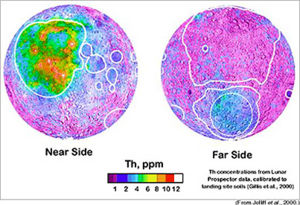KREEP
Some of the following information may be taken from outdated sources and may be incorrect or incomplete. You can help Lunarpedia by correcting it
KREEP is an acronym used in geochemistry to represent a mixture of K-potassium, REE-rare earth elements, and P-phosphorus. It is not only the main source of these elements on the moon, but also many other trace elements such as uranium, thorium, fluorine, chlorine, and zirconium.
Origins and Distribution
It is believed that approximately 4.5 billion years ago the earth suffered a cataclysmic collision with another solar body roughly the size of Mars. The disk of debris from this collision accreted over time to form a moon very different from the one we know today. The process was a violent one, resulting in an ocean of magma covering the entire lunar surface. Through the cooling of this ocean of magma KREEP was isolated from other lunar minerals, as explained below.
KREEP is a composite of what scientists term "incompatible elements": elements which cannot fit easily into the crystal structures formed by cooling magma and tend to separate out into the remaining liquid phase. This resulted in a KREEP rich magma sandwiched between the floating anorthositic plagioclase of the lunar crust and the precipitating minerals, such as olivine, that formed the mantle. Although it was common belief that this process would form an evenly distributed global layer of KREEP magma, the Gamma Ray Spectrometer aboard Lunar Prospector shows that KREEP is mainly concentrated in the area of Oceanus Procellarum and Mare Imbrium. This unusual geological region is now referred to as the Procellarum KREEP Terrane. Deep penetrating impact basins away from this region show only modest or no KREEP concentrations in their ejecta and rims.
KREEP is kicked up in the ejecta or "splash out" produced in impacts taking place on or in close proximity to basaltic lava flows, as well as in major impacts which penetrate the crust. Some of this splash out was brought back by the Apollo 15 mission in fragments generally smaller than 1cm. These samples are believed to have originated after the impact which formed the Imbrium basin[1].
Applications
It is considered a convenient tracer for researchers seeking to chronicle the volcanic history of the lunar surface, as well as impacts of celestial bodies.
KREEP as an Ore
"On the Moon, elements have not been concentrated into what we would call ores through geological processing in the presence of water. We have instead "poor ores" if you can call them ores at all.
So wherever we find special concentrations, these are certainly places to consider in mining and processing operations. We will want to get beyond the new stone age on the Moon, and have a post-Flintstonian civilization :-)
So to get alloy ingredients for workable metals, nutrients for agriculture, industrial reagents and much more, special concentrations such as ilmenite and KREEP will play a vital role." - Peter Kokh
Contents of KREEP and brief list of applications
- Fluorine - useful in fluorine reaction of regolith to produce oxygen
- Sodium - industrially can be used to dope mare basalt in order to lower its melting point far enough so that it can be used as a glass matrix for glass fibers made from highland regolith with a higher melting point.
- Potassium - can be used industrially for doping basalt (see sodium). Agriculturally it is an important component of some fertilizers. (most notably potassium phosphate)
- Phosphorus - Also an important component in some agricultural fertilizers (most notably potassium phosphate)
- Chlorine - useful for making hypochlorous acid used in water purification.
- Zirconium - uses: a refractory material, in nuclear reactors, piping for corrosive chemicals, hip and knee replacement, jewelry (cubic zirconia)
- Thorium - Useful as a fuel in some nuclear reactors, as well as an ingredient in some super alloys
- Uranium - A nuclear power source
Rare Earth Elements - see related article
- Scandium - Used as a strengthening agent and thermal stabilizer in aluminum alloys.
- Yttrium - used in microwave filters (radar), acoustic transmitters/transducers, infrared lasers, white LEDs, superconductors, glass (camera lenses), ceramics (fireproof bricks), many metal alloys (strengthener and deoxidizer).
- Lanthanum -
- Cerium
- Praseodymium
- Neodymium
- Samarium
- Europium
- Gadolinium
- Terbium
- Dysprosium
- Holmium
- Erbium
- Thulium
- Ytterbium
- Lutetium








